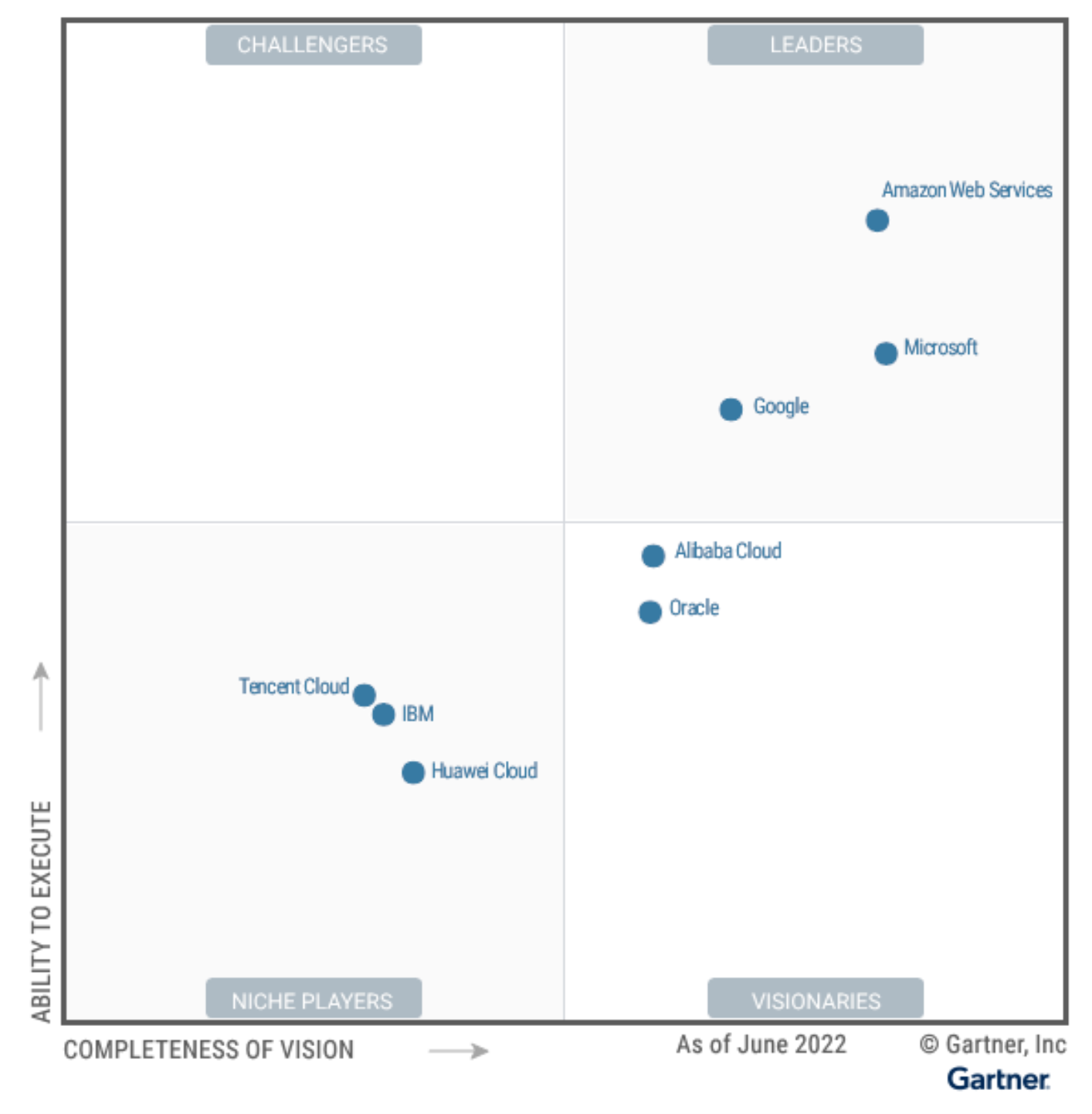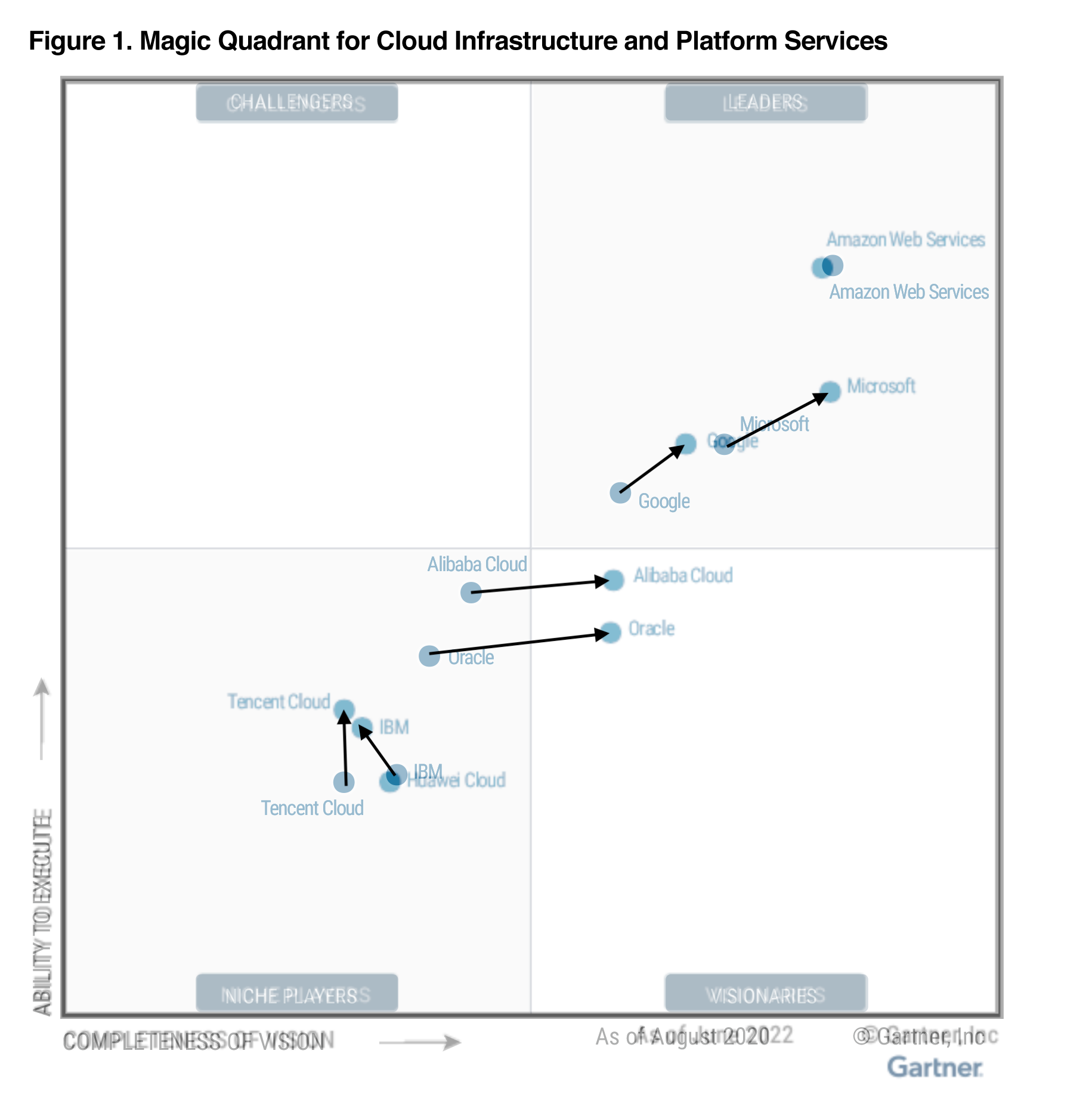AWS has been named the leader for its 12th consecutive year with Gartner noting the company has the greatest breadth and depth of any provider in the market for cloud infrastructure and platform services (CIPS).
Microsoft and Google are similarly celebrating their recurring position in the leader quadrant, both having made some gains in AWS’s space - which, while still comfortable in the top place, is not pulling away.
However, Oracle and its Oracle Cloud Infrastructure, or OCI, platform is the real news here.
|
|
After all, it's no surprise to anyone that AWS is the leading hyperscaler and that Microsoft Azure and Google Cloud Platform are coming next. But it may well surprise you that Oracle - launched in late 2016 - has jumped from niche player to visionary, and is seeing relentless growth.
You can see the 2022 Magic Quadrant here. If you're on mailing lists from the big cloud providers you’ll likely have seen it already, because, understandably, they’ve been keen to flag their leading roles.

However, iTWire has overlayed the 2022 quadrant against the 2020 quadrant to give an interesting picture of what’s changed over the last two years, and this is much more interesting, in my view. And here is where we see the OCI leap.

Gartner reports this is against Oracle's historically dim reputation in some quarters due to tough compliance enforcement, aggressive sales, and inconsistent support. In other words, OCI’s growth is driven primarily by those finding appeal in the offering, vs. those who have an affection for Oracle and opt for OCI from brand loyalty.
It's clear Oracle is doing something right to achieve the growth it is seeing, and the reality is Oracle is out-innovating the competition in certain areas.
One of these is the sovereign cloud. This special subset refers to isolated in-country platforms with independent authentication, storage, and compliance requirements that Governments mandate. The competition has sovereign cloud offerings and in fact, within Australia AWS, Azure, Google, IBM, Macquarie Telecom, NEXTDC, and Equinix, among others including Oracle, are all certified strategic providers by the Federal Government.
However, in general, it's Gartner's considered opinion that the AWS approach is “timid” while Oracle - used to working with Governments worldwide for several decades - has made sovereign cloud a clear and developed strategic policy.
A second factor, and in my view a significant one, is Oracle’s greater flexibility in virtual machine sizing than any of its competitors.
When you choose an AWS EC2 or an Azure virtual machine you select a pre-defined configuration of CPU cores and RAM. These increase together, meaning if you require a certain amount of RAM for, say, an in-memory cache you must also take the higher number of CPU cores that come with it, regardless of how computationally intensive your requirements may be.
Oracle started life offering flexible sizing from inception. You can explore this in the OCI cost estimator by selecting compute, and then options present themselves for you to dial up or down the number of CPUs and RAM to suit your own purposes. There are some caveats; you have a cap on the total amount of RAM and CPUs, and the amount of RAM per CPU, but for the most part it’s a choose-your-own-adventure if you have a reason to venture beyond the pre-made shapes available.
An example in practice is iLiveIT; this business delivers hyper-personalised customer experiences. Think, for instance, of your electricity bill or some other invoice. Instead of receiving the same old form as everybody else, iLiveIT can send a video explainer walking through your specific bill and providing recommendations for different plans or other content relevant to, and tailored to, your circumstance. iLiveIT COO Riaan Groenewald previously explained to iTWire that they evaluated other cloud providers but it was Oracle’s flexible shaping that enabled them to do what they do by mixing and matching CPU and RAM as needed, to provide raw power at a cost-effective price.
I'd been curious about this in the past. It makes sense, after all, that AWS (say) provide machines in specific configurations to optimise their use of the underlying hardware. Let’s say you have a physical server in your rack that has 128 cores and 512GB RAM. So, you could offer 64 virtual machines with two cores and 8GB RAM, or 32 virtual machines with four cores and 16GB RAM, or 16 virtual machines with eight cores and 32GB RAM - or other configurations and ultimately pack these into the hardware like Tetris building blocks.
By contrast, if you allow the user to pick the amount of RAM and CPU they want it becomes much more difficult to utilise your hardware optimally. Well, so I’d have thought.
Wanting to understand this, I previously raised it with OCI VP product Karan Batta. That was back in 2018 but his words always stuck with me; he said what I thought was true, but “we put the customer’s interests above our needs.”
“Why be constrained by shapes and sizes? Oracle Cloud’s underlying secret sauce is the bin packing - all of our virtualisation stack, I/O virtualisation, business logic runs outside the machine. It’s a separate piece of silicon allowing us to provision whatever the customer needs. The customer simply picks their number of cores and quantity of RAM and they’re done,” Batta explained.
I spoke with Batta again in 2020 who told me, at that time, OCI had made available the Nvidia A100 Tensor Core GPU on bare metal instances - an intense processor for complex AI models and deep learning systems. "We have the largest, most performant, and most cost-effective A100 offering in the cloud because we offer double the memory and more local storage than competitors. This is the GPU instance customers have been waiting for to move to the cloud and deliver important breakthroughs,” he said.
I've spent a lot of time speaking with AWS executives and product teams, and have announced many AWS products. This is also true for Azure. However, my own personal experience is while these companies speak about their impressive, and ongoing, release of new features, it’s only been Karan Batta from OCI who has enthused effusively and passionately about the underlying hardware of their platform. Gartner highlights that OCI is out-innovating competitors and it’s my sincere belief the hardware side is a significant part of this.
There is more to say; Oracle has a commitment to on-premises cloud delivery for Governments and large enterprises who need the flexibility of cloud but the security of on-prem, and there is its always-free tier which offers more items for free for longer than the competition.
Putting it all together this is why the real news in Gartner’s latest magic quadrant isn’t that the top dog is still the top dog; it’s that OCI has moved significantly and is on the rise.
(You'll note Alibaba Cloud has also made significant gains, and iTWire also wants to highlight that success. However, Alibaba is a riskier choice for those doing business outside China and South-East Asia. Further, Alibaba’s lead in the region is likely to diminish due to regulatory influence combined with highly-active Chinese competitors such as Huawei, which appears in Gartner's quadrant for the first time in 2022, and Tencent.)
Title image credit: giografiche from Pixabay











































